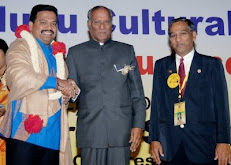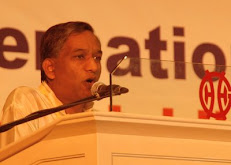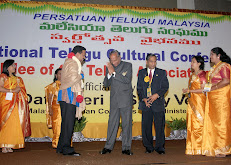TELUGU - Italian of the East" - Niccolo Da Conti, 15th Century
"dESa bhAshalaMdu telugu lessa" - tuLuva rAju SrI kRshNadEvarAya
Telugu is the sweetest of all Indian languages - Great Tuluva Emperor Sri Krishnadeva Raya, 16th Century
"suMdara teluMgiL paaTisaitu" - SrI subrahmaNya bhArati
Let us sing in Sweet Telugu - by Tamil poet Sri Subrahmanya Bharati, 20th Century
Grim translation scenario not helping Classical Telugu
Telugu may have attained classical language status, but very few people will get to read any of its literary texts, if current translation trends continue. At present, translation of Telugu literary works is taken up sporadically, and that too only into English and not Indian vernacular languages.
In view of the recently accorded classical language status for Telugu and Kannada languages as well as the establishment of a Translation Mission of India, a ninth CLAI (Comparative Literature Association of India) biennial international conference being held at the University of Hyderabad acquires significance.
Speaking of the grim Telugu translation scenario, M Sridhar, a Telugu translator and professor of English in the University says, "Given a choice, people would prefer reading Adiga or Chomsky novels rather than Chaya Devi or Raavi Shastry. Texts and literature sourced from English are still perceived as windows to the world." Most other Indian languages face a similar situation, he added.
Market dynamics go against cross vernacular translations, so publishers and authors are also drawn to higher sales and wider exposure that English provides. Then there is the problem of publishers playing favourites when selecting the recipient language, with Kannada, Oriya and Bengali being popular languages.
"Translation can be an important medium of networking the country and also gives an insight into the linguistic heritage and shared values of different regions," says Tutun Mukherjee, head, department of Comparative Literature in the University of Hyderabad adding that the conference will also take up travel writing, literature of the marginalised, tribal literature, philosophy, religion and women's writing.
However, recent Central government grant of Rs 90 crores to the Mission towards translation of knowledge-based texts into 23 vernacular languages is raising hopes of translators.
Andhra Pradesh: 5 walled cities from 300 B.C. unearthed
Andhras flourished during the time of Chandragupta Maurya much before the advent of the Satavahanas, and were said to be as powerful as Mauryans. They had 30 fortified walled cities way back in 300 BC, wrote the Greek traveller Megasthenes in his Indika. In what could be an exciting discovery, the State Department of Archaeology and Museums has identified five of those 30 walled cities.
The Department has found physical evidence proving Megasthenes right and by the same token –– throwing light on the existence of Andhras and Telugu language before the Satavahana period. The study is part of a project taken up to find the 30 walled cities mentioned by the Greek traveller and historian in his travelogue.
‘‘Though the Andhras were mentioned in books dating back to 1,000 BC, we have physical evidence like coins and pottery only from the Satavahana period (200 BC - 200 AD). Our research based on Indika of Megasthenes strengthens the theory that the Andhras existed before the Satavahanas.
Excavation of these sites will provide more physical evidence on history, administration, language, customs and traditions of our ancestors,’’ said P Chenna Reddy, Director of Archaeology and Museums Department.
Megasthenes is believed to have visited India as an Ambassador of Seleucus I of Syria to the court of Chandragupta Maurya around 305 BC.
In Indika, Megasthanes indicates that the Andhra (mentioned as Andarae) kings belonged to a powerful race and possessed an army of 100,000 infantry, 2,000 cavalry, 1,000 elephants and had 30 well-built fortified towns.
With Telugu obtaining classical language status, the project assumes importance and is likely to give an insight into its origins and the historical existence of Andhras. The officials have so far examined 18 sites with historical importance and singled out five.
Archaeologists recovered bricks, pottery, coins and other evidence from these sites at Dhoolikatta, Kotilingala (both Karimnagar district), Satanikota (Kurnool district), Dharanikota (Amaravathi) and Bodhan (Nizamabad district).
The project was taken up in October, 2005 and efforts are on to identify the remaining Megasthanes towns in Andhra Pradesh as well as at a few places in Maharashtra, Karnataka, Chhattisgarh and Tamil Nadu.
copied from: Teluguanam.blogspot.com
Oinam Mangi
59 minutes ago



.jpg)
.jpg)
.jpg)
.jpg)
.jpg)


No comments:
Post a Comment